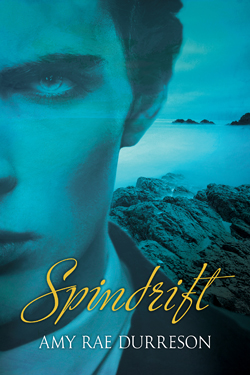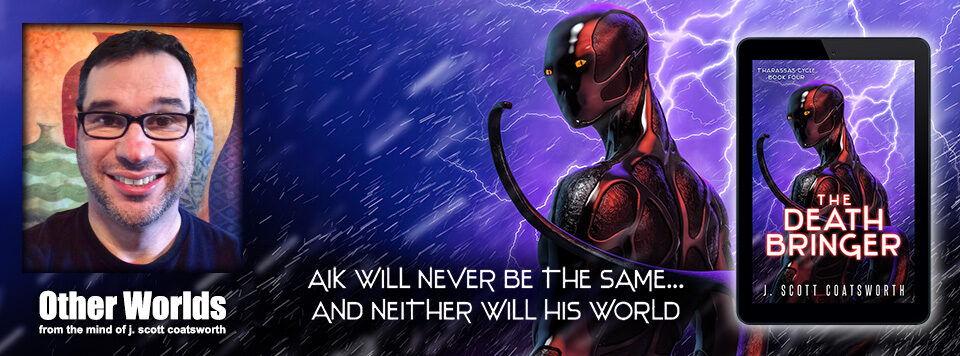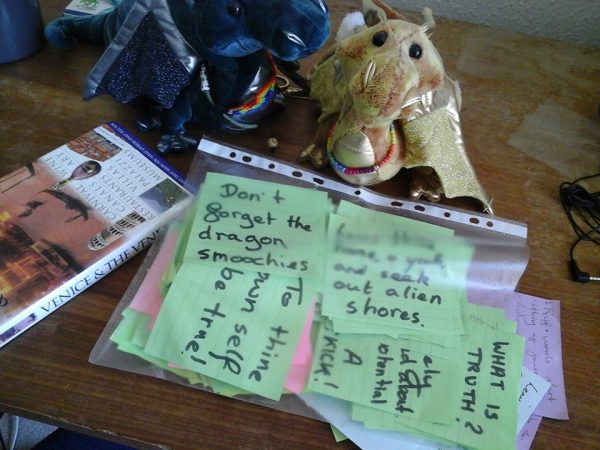Welcome to my weekly Author Spotlight. I’ve asked a bunch of my author friends to answer a set of interview questions, and to share their latest work.
Today, Amy Rae Durreson – my has a terrible weakness for sarcastic dragons, shy boys with sweet smiles, and good pots of tea. She is yet to write a shy, tea-loving dragon, but she’s determined to get there one day (so far, all of her dragons are arrogant gits who prefer red wine).
Thanks so much, Amy, for joining me!
J. Scott Coatsworth: When did you know you wanted to write, and when did you discover that you were good at it?
Amy Rae Durreson: I always wanted to be a writer. I’ve still got the opening paragraph of a story I wrote when I was seven, set in the year 3000, but I didn’t get started properly until I was twelve, when I blithely launched into what I intended to be a twelve book epic fantasy series. I managed to cram every single fantasy cliché going into that thing, which I never finished and is now gathering dust in a drawer, but I’ve been writing ever since. Getting good at it took a lot longer. Some people seem to have a natural ear for the flow of a sentence and the twists and revelations of a plot. I didn’t, but I wrote and I wrote and I wrote. Eventually, after thousands and thousands of words and, just as importantly, reading across all sorts of genres, I found my own voice.
JSC: How would you describe your writing style/genre?
ARD: These days my work is divided between two genres, epic fantasy and contemporary ghost stories. I write big sweeping books about dragons and their loyal hoards facing down dark forces, and quiet, creepy things set in the English countryside. A lot of the time, I alternate between those genres. I aim for restrained lyricism in both, though I’ll leave it to my readers to decide how successful I am in that. You have to be careful not to overdo descriptive details, but I do try to weave together the details that matter to my characters. With high fantasy, I try to add in a hint of high style, but ghost stories are more about the slow build of atmosphere—the play of light and shadows, echoes and reflections. Ghost stories need to be subtle, so part of the challenge is not overdoing it.
JSC: What was your first published work? Tell me a little about it.
ARD: My first published story was a little retelling of a folk tale set in a desert world. It was the first of a handful of stories I sold under my real name. My first story as Amy Rae Durreson was The Ghost of Mistletoe Lock, which was part of Dreamspinner’s Christmas anthology in 2012. The ghost in that one is a minor supporting character and although I loved writing her scenes, I would never have dreamed then that I would fall in love with the genre as I have.
JSC: What’s your writing process?
ARD: I’m a planner. I’ll usually let a story sit in the back of my head for weeks or months, sometimes years, before I work out a formal outline. I then work through it from beginning to end, gathering speed and adapting my plan as I go. After that there’s no process beyond getting the words on the page. Most of my writing is done at evenings and weekends, but I usually manage to scrap out a few hundred words on my phone while waiting at the bus stop or in lunch breaks. Making the most of those otherwise wasted minutes counts.
JSC: Tell us about a unique or quirky habit of yours.
ARD: I make endless cups of tea to fuel my writing, but forget about most of them halfway down the cup and end up using the dregs to water my plants. I have some very healthy houseplants.
JSC: If you could sit down with one other writer, living or dead, who would you choose, and what would you ask them?
ARD: Just one? Although there are some contemporary writers I’d love to talk to, many of the authors I admire most, like Ursula LeGuin, have written extensively on writing. I’d probably go further back in time, to people whose views haven’t survived and whose poetics were profoundly different. Geoffrey Chaucer would be a possibility—I suspect he’d have a lot of fascinating stories to tell about the balance of poetry and his other work for the crown, but I’d really like to talk to someone whose very identity has vanished into the mists of history, someone whose approach to storytelling is so different from today’s that it might profoundly change mine. So, I’ll go with the Beowulf poet, whoever they were and whenever they wove together that mass of story and oral tradition into a poem whose themes still resonate down the centuries.
JSC: What action would your name be if it were a verb?
ARD: Contextualise (which probably needs some context, right?). Nothing has meaning in isolation, whether it’s the first reaction a man has to seeing a dragon, or the distinct sound of a footstep on a creaky floorboard (only terrifying, after all, if the room looks completely empty). Also, I’m an English teacher in my day job, so it’s a skill I spend a lot of time teaching.
JSC: What kind of character or topic have you been dying to try to write, but you’ve never worked up the courage?
ARD: I’ve got two projects like that on my wish list, and they will both require so much in-depth research that I’m slightly daunted. One is set during and around WW1, about artists, in particular those who worked with early plastic surgeons on facial reconstructions after the war. The other is a queer retelling of Arthurian legends, set in the dark ages.=
JSC: If you had the opportunity to live one year of your life over again, which year would you choose?
ARD: I wouldn’t. Even the worst years have made me who I am, and I wouldn’t want to let that go. And, in the same way, the good years wouldn’t feel the same to the person I am now. What’s next is always more interesting.
JSC: What are you working on now, and when can we expect it?
ARD: I’ve recently signed the contract for another dragon book, which will be out in spring 2017, but currently I’m at work on another ghost story. It’s still in the very early stages, but it’s set in a boarding school during a heatwave and has a particularly murderous ghost.
 And now for Amy’s new book: Spindrift:
And now for Amy’s new book: Spindrift:
When lonely artist Siôn Ruston retreats to the seaside village of Rosewick Bay, Yorkshire, to recover from a suicide attempt, he doesn’t expect to encounter any ghosts, let alone the one who appears in his bedroom every morning at dawn. He also doesn’t expect to meet his ghost’s gorgeous, flirty descendant working at the local museum… and the village pub, and as a lifeboat volunteer. But Mattie’s great-great-grandfather isn’t the only specter in Rosewick Bay, and as Siôn and Mattie investigate an ill-fated love affair from a bygone era, they begin a romance of their own, one that will hopefully escape the tragedy Mattie’s ancestor suffered.
But the ghosts aren’t the only ones with secrets, and the things Siôn and Mattie are keeping from each other threaten to tear them apart. And all the while, the dead are biding their time, because the curse of Rosewick Bay has never been broken. If the ghosts are seen on the streets, local tradition foretells a man will drown before the summer’s end.
Buy Links
Excerpt
The first light of the summer dawn was spilling softly through the dormer window and the lace curtains, creating thin patterns of light on the polished wooden floor and tufted rag rug in front of the unused hearth. Those seagulls were still squabbling outside his window, and he could just hear the sea breathing softly against the harbor bar.
He was alive. He was sane again. He was safe.
He was still alone.
But that was one of the thoughts he had learned to guard against, so he took another steadying breath, pushed himself up against the pile of lace-trimmed pillows, and went through his mantra again.
Alive. Sane. Safe. It had been three months since the bridge, and—with the help of a change of scene, mandatory therapy, and plenty of pills—he knew everything he had seen and felt up there had been false. He no longer believed that death was the only logical conclusion.
Tempting sometimes, but not logical.
Another breath, and this time he said the three words aloud to remind himself more firmly. “Alive. Sane. Safe.”
It helped to be here, in a sunlit room in this quiet house. Siôn had been reading before he went to sleep, Gavin Francis’s travelogue True North, and he reached out for his e-reader to keep going. There was nothing like the fascinating yet distant details of life in a cold climate to soothe his restless mind.
But as he turned, he heard a soft noise from his bedroom door. Then he saw the man standing there.
He was an ordinary-looking young man, of average height and squarely built, not much more than twenty. His dark hair was cropped close to his skull, and his face was ruddy and weathered. He had a slightly pointed face, not unhandsome, but not remarkable either, his expression solemn, although there was something around his eyes that suggested he could laugh. He wore a heavy navy blue jersey, cable-knit in complex patterns that drew Siôn’s eye, and faintly oily looking.
He had a thin little mustache and a gray leather flat cap, both of the sort Siôn associated with period films and a particular subset of urban hipster, and they seemed out of place in this little coastal retreat.
The initial surprise was giving way to indignation. Siôn had let the cottage for the next three months, and the agency had promised him that he would be left alone to enjoy it. They had also mentioned that the owner’s grandson would be staying in the basement flat once his university term was over, and “if you need owt and can’t get us on t’ phone, young Mattie will take a gander for thee.”
Siôn had managed to hide his instinctive grimace at both the idea and the exaggerated-cod Yorkshireism being thrown in his tourist face, but at least he now had a clue who this intruder was and how he had managed to get in. Bloody students.
Irritated, he snapped out, “What the devil do you think you’re doing?”
The man turned his head toward Siôn. His eyes were very wide and a little unfocused, as if they were seeing things Siôn could not, and suddenly the room felt icy, all the soft heat of early June seeping away like a retreating tide. The hairs on his arms stood on end, and his back cramped.
“Sarah,” the man said, and his voice was as cracked and distant as an old record, fading more with every syllable. “…Sorry… d—ned… shua….”
And he came forward across the room, bringing with him a stink of salt and rotten seaweed and something worse, something old and deep and dead.
Siôn couldn’t move.
Frozen in place, naked under the duvet, he watched this man—this dead thing—come gliding closer and closer to him, and he couldn’t move, couldn’t breathe, couldn’t even flinch.
The ghost passed across the room, his blank eyes unblinking, brushed past the bed, and walked toward the wide, low window where the dawn light was blazing in, thin and white and dazzling. He stepped into it and was gone, leaving behind only a lingering smell of death.
Author Bio
Amy has a terrible weakness for sarcastic dragons, shy boys with sweet smiles, and good pots of tea. She is yet to write a shy, tea-loving dragon, but she’s determined to get there one day (so far, all of her dragons are arrogant gits who prefer red wine). Amy is a quiet Brit with a degree in early English literature, which she blames for her somewhat medieval approach to spelling, and at various times has been fluent in Latin, Old English, Ancient Greek, and Old Icelandic, though these days she mostly uses this knowledge to bore her students. Amy started her first novel twenty-one years ago and has been scribbling away ever since. Despite these long years of experience, she has yet to master the arcane art of the semicolon.

